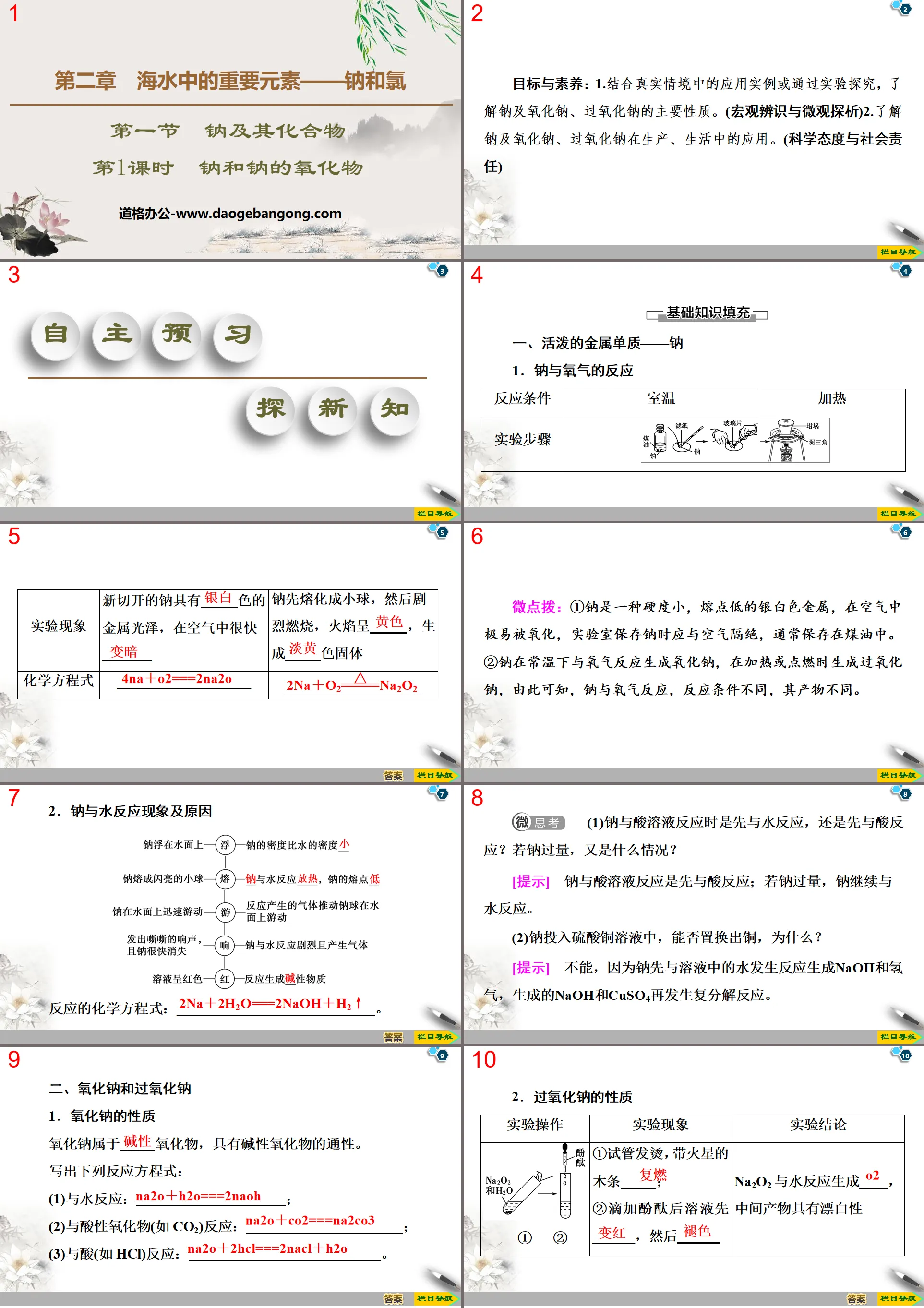People's Education Press High School Chemistry Compulsory Course I
Cantonese Education Edition Ninth Grade Chemistry Volume 1
Beijing Curriculum Reform Edition Ninth Grade Chemistry Volume 2
People's Education Press Ninth Grade Chemistry Volume 1
Beijing Curriculum Reform Edition Ninth Grade Chemistry Volume 1
Lu Ke Edition High School Chemistry Compulsory Course 1
Lu Jiao Edition Ninth Grade Chemistry Volume 1
People's Education Press Ninth Grade Chemistry Volume 2
Cantonese Education Edition Ninth Grade Chemistry Volume 2
Hunan Education Edition Ninth Grade Chemistry Volume 1
Lu Ke Edition High School Chemistry Compulsory Course 2
People's Education Press High School Chemistry Compulsory Course 2
Hunan Education Edition Ninth Grade Chemistry Volume 2
Lu Jiao Edition Ninth Grade Chemistry Volume 2

| Category | Format | Size |
|---|---|---|
| People's Education Press High School Chemistry Compulsory Course I | pptx | 6 MB |
Description
"Sodium and Sodium Oxides" Sodium and its Compounds PPT
Part One: Goals and Competencies:
1. Understand the main properties of sodium, sodium oxide, and sodium peroxide through application examples in real situations or through experimental exploration. (Macroscopic identification and microscopic analysis)
2. Understand the applications of sodium, sodium oxide, and sodium peroxide in production and life. (Scientific attitude and social responsibility)
Sodium and sodium oxide PPT, part 2 content: independent preview to explore new knowledge
1. Active metal element - sodium
1. reaction of sodium with oxygen
Micro tip: ① Sodium is a silver-white metal with low hardness and low melting point. It is easily oxidized in the air. When storing sodium in the laboratory, it should be isolated from the air and usually stored in kerosene. ②Sodium reacts with oxygen at room temperature to generate sodium oxide, and when heated or ignited, it generates sodium peroxide. It can be seen that when sodium reacts with oxygen, the reaction conditions are different, and the products are different.
2. Phenomenon and causes of reaction between sodium and water
Chemical equation for the reaction: ____________________________.
2. Sodium oxide and sodium peroxide
1. Properties of sodium oxide
Sodium oxide is a ______ oxide and has the properties of an alkaline oxide.
Write the following reaction equation:
(1) Reacts with water: ___________;
(2) Reaction with acidic oxides (such as CO2): ___________;
(3) Reaction with acid (such as HCl): ___________.
2. Properties of sodium peroxide
Write the following reaction equation:
(1) Reaction with H2O: __________________;
(2) Reaction with CO2: __________________.
Sodium and sodium oxide PPT, the third part: core breakthroughs and difficult difficulties
Changes in sodium concentration when exposed to air
1. Metal sodium is exposed to the air for a long time and eventually completely transforms into Na2CO3 powder. The main changes and phenomena in this process are:
2. The chemical equation that undergoes the main changes is
①4Na+O2===2Na2O.
②Na2O+H2O===2NaOH.
④2NaOH+CO2===Na2CO3+H2O, Na2CO3+10H2O===Na2CO3·10H2O.
⑤Na2CO3·10H2O===Na2CO3+10H2O.
1. When a piece of silvery-white metallic sodium is placed in the air, a series of changes will occur: the surface quickly darkens, "sweats", and turns into a white solid (powder). Which of the following statements is correct ()
A. The surface darkens rapidly because sodium reacts with oxygen in the air to form sodium peroxide
B. "Sweating" is because the generated sodium hydroxide absorbs H2O in the air and forms a solution on the surface.
C. Finally turns into sodium carbonate crystals
D. All chemical reactions in this process are redox reactions
B [ The surface of sodium darkens quickly when exposed to the air. This is because Na reacts with O2 to form Na2O. Item A is incorrect; Na2O reacts with water to form NaOH, and NaOH absorbs H2O and CO2 in the air to form Na2CO3• 10H2O, Na2CO3·10H2O gradually weather and dehydrate, and finally become Na2CO3 powder, B is correct, C is wrong; only the oxidation of sodium in this process is a redox reaction, item D is wrong. ]
2. Metal sodium was produced by electrolysis of sodium hydroxide in 1807. This principle was applied to industrial production and was successful only in about 1891. In 1921, the industrial method of electrolyzing sodium chloride to produce sodium was realized. The reaction principle is: 2NaCl (melted) ===== electrolysis 2Na + Cl2↑.
Answer the following questions about elemental sodium:
(1) Among the following, the correct method for preserving metallic sodium is ________.
A. Put in a brown bottle B. put in fine sand
C. Put in water D. put in kerosene
Sodium and sodium oxide PPT, part 4: meeting standards in class and improving literacy
1. Take a piece of metallic sodium and heat it in a burning spoon. The correct description of the following experimental phenomenon is ()
① The metal melts first ② Burns in the air and releases yellow sparks ③ After burning, a white solid is obtained ④ The flame is yellow when burning ⑤ After burning, a light yellow solid is produced
A. ①②B. ①②③
C. ①③ D. ①④⑤
D: The melting point of sodium is only 97.8 ℃, and it melts immediately when heated. Sodium is a very reactive metal. When heated, it combines with oxygen to form sodium peroxide, which is light yellow. The flame of sodium burning in air is yellow. ]
2. When an appropriate amount of metallic sodium is put into the following solution, gas is released but no precipitation is produced ()
A. Hydrochloric acid B. Saturated sodium hydroxide solution
C. FeCl3 solution D. CuSO4 solution
A: The reaction between sodium and aqueous solution releases hydrogen gas; item A, the reaction is 2Na+2HCl===2NaCl+H2↑, only the gas does not precipitate; item B, the NaOH solution is a saturated solution, after adding sodium, water is consumed and hydrogen oxidation is precipitated Sodium crystal; item C, the sodium hydroxide generated by the reaction of sodium and water can further react with FeCl3 to produce iron hydroxide precipitation; item D, the sodium hydroxide generated by the reaction of sodium and water can further react with CuSO4 to produce copper hydroxide precipitation . ]
Keywords: Free download of the PPT courseware for high school chemistry compulsory course 1 of the People's Education Press, PPT download of sodium and sodium oxides, PPT download of sodium and its compounds, .PPT format;
For more information about the PPT courseware "Sodium and its Compounds Sodium and Sodium Oxides", please click on the Sodium and Its Compounds ppt Sodium and Sodium Oxides ppt tag.
"Sodium and Its Compounds" Important elements in seawater - sodium and chlorine PPT (several compounds of sodium in lesson 2):
"Sodium and Its Compounds" Important Elements Sodium and Chlorine in Seawater PPT (Lesson 2: Several Compounds of Sodium) Part One Content: Learning Objectives Course Standards 1. Understand sodium peroxide, sodium carbonate and sodium bicarbonate through experimental exploration main properties. 2. Combined with real situations..
"Sodium and Its Compounds" Important elements in seawater - sodium and chlorine PPT (Lesson 1: Active metal element - sodium):
"Sodium and Its Compounds" Important Elements Sodium and Chlorine in Seawater PPT (Lesson 1: Active Metallic Elemental Sodium) Part One Content: Learning Objectives Course Standards 1. Understand the main properties of sodium through experimental exploration. 2. Initial formation of the properties of matter based on atomic structure..
"Several Compounds of Sodium - Flame Color Test" Sodium and its compounds PPT:
"Flame Color Test of Several Compounds of Sodium" Sodium and its Compounds PPT Part One Content: Literacy Objective 1. Understand the chemical change process of sodium peroxide, sodium carbonate, and sodium bicarbonate through experiments. Master the properties and uses of important compounds of sodium. Cultivation Experiments explore consciousness. 2..
File Info
Update Time: 2024-11-22
This template belongs to Chemistry courseware People's Education Press High School Chemistry Compulsory Course I industry PPT template
"Sodium and Sodium Oxides" Sodium and its Compounds PPT Simple campus recruitment activity planning plan summary enterprise and institution recruitment publicity lecture PPT template is a general PPT template for business post competition provided by the manuscript PPT, simple campus recruitment activity planning plan summary enterprise and institution recruitment promotion Lecture PPT template, you can edit and modify the text and pictures in the source file by downloading the source file. If you want more exquisite business PPT templates, you can come to grid resource. Doug resource PPT, massive PPT template slide material download, we only make high-quality PPT templates!
Tips: If you open the template and feel that it is not suitable for all your needs, you can search for related content "Sodium and Sodium Oxides" Sodium and its Compounds PPT is enough.
How to use the Windows system template
Directly decompress the file and use it with office or wps
How to use the Mac system template
Directly decompress the file and use it Office or wps can be used
Related reading
For more detailed PPT-related tutorials and font tutorials, you can view: Click to see
How to create a high-quality technological sense PPT? 4 ways to share the bottom of the box
Notice
Do not download in WeChat, Zhihu, QQ, built-in browsers, please use mobile browsers to download! If you are a mobile phone user, please download it on your computer!
1. The manuscript PPT is only for study and reference, please delete it 24 hours after downloading.
2. If the resource involves your legitimate rights and interests, delete it immediately.
3. Contact information: service@daogebangong.com
"Sodium and Sodium Oxides" Sodium and its Compounds PPT, due to usage restrictions, it is only for personal study and reference use. For commercial use, please go to the relevant official website for authorization.
(Personal non-commercial use refers to the use of this font to complete the display of personal works, including but not limited to the design of personal papers, resumes, etc.)
Preview










